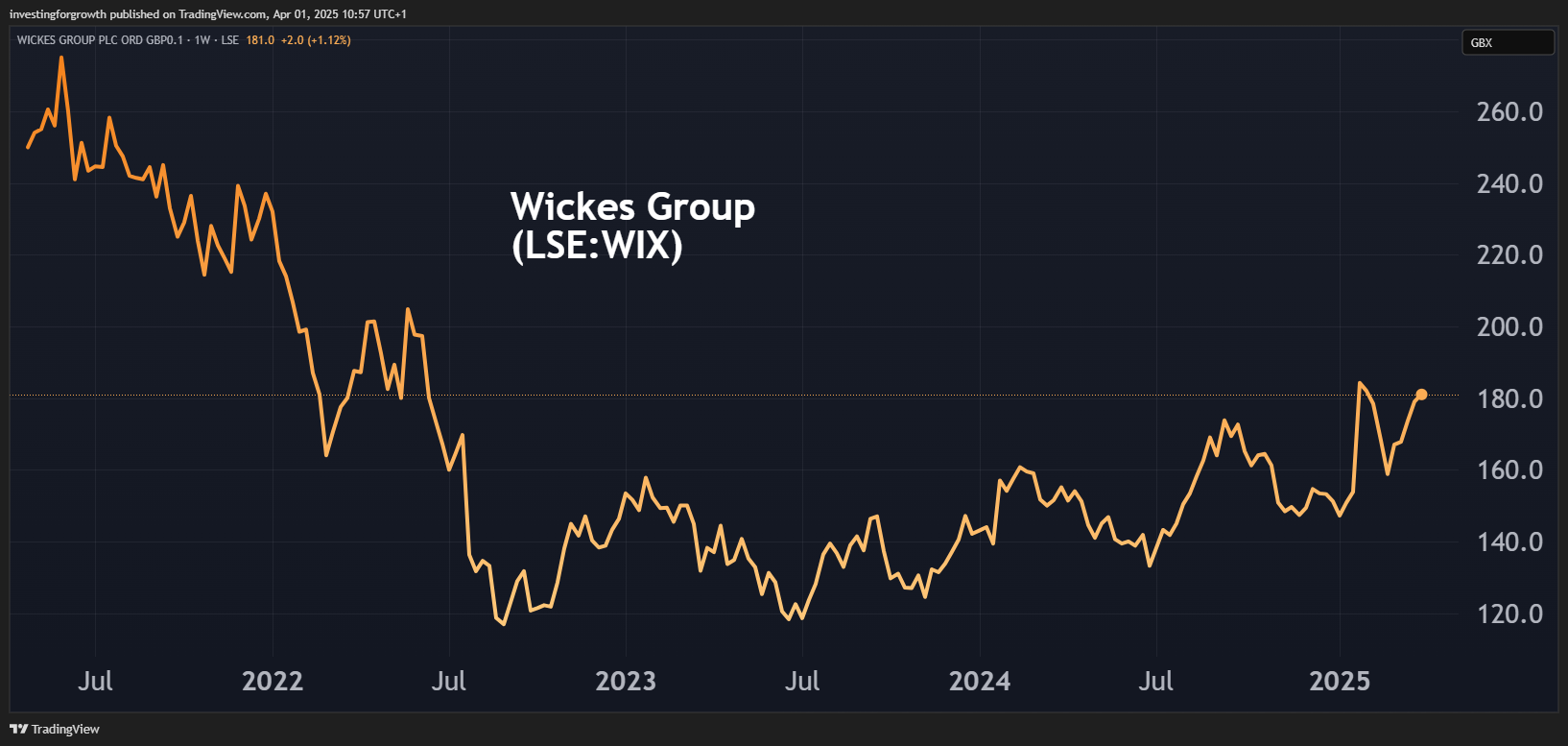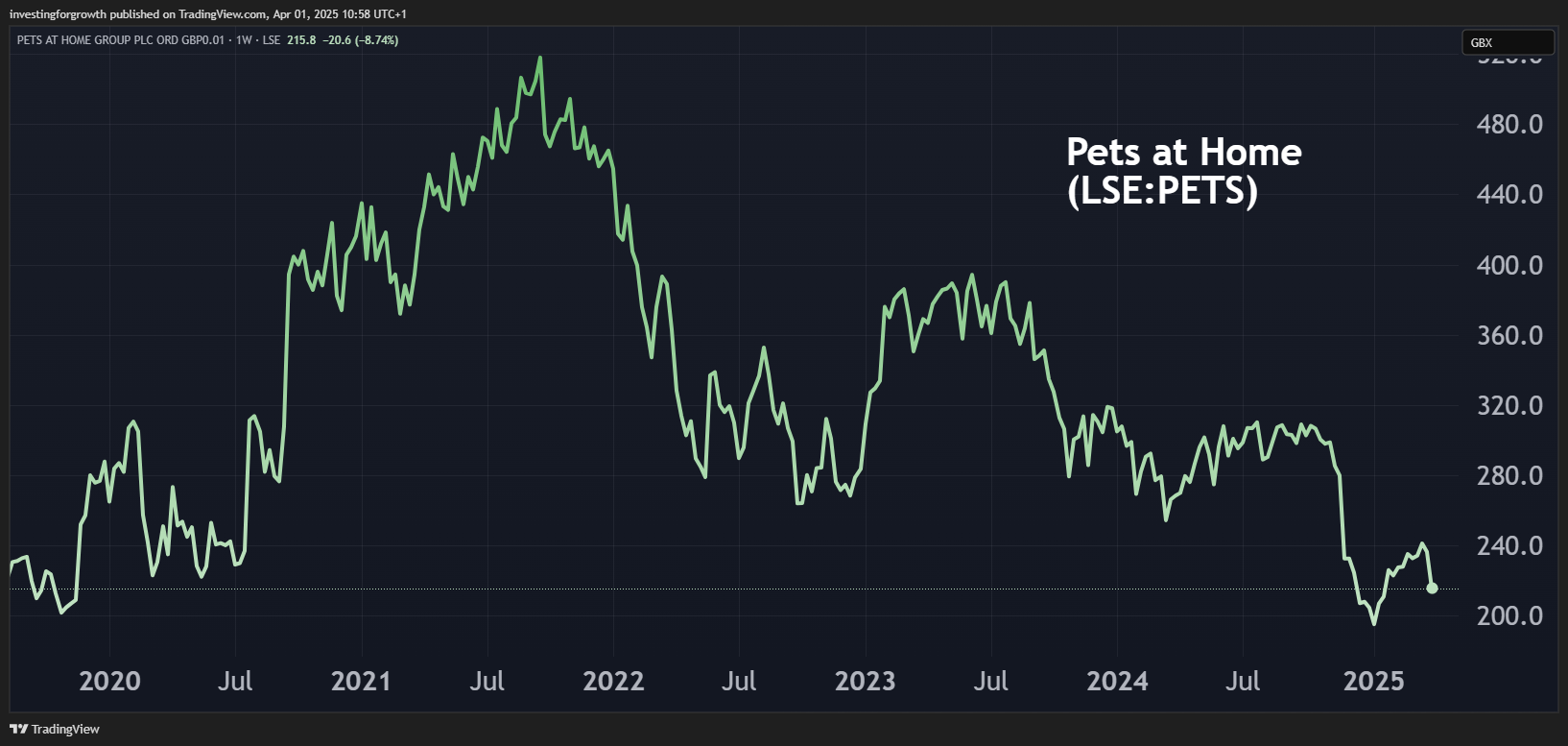Stockwatch: why I’m upgrading one share and buying another
One of these UK retail stocks is in an uptrend and worth acquiring, believes analyst Edmond Jackson. Another is more speculative but might be an opportunity.
1st April 2025 11:38
by Edmond Jackson from interactive investor

Since February 2023, I have been intrigued to compare and contrast small-cap retailer Wickes Group (LSE:WIX) and mid-cap Pets at Home Group (LSE:PETS).
Classic questions such as whether to favour a steady “recovery” share on a decent yield over a de-rated “growth” share that lost its mojo; how a cycle in shares can exist as growth becomes recovery and potentially vice-versa; to what extent should you take notice of insider and institutional dealing, or whether you should strive for an independent view. In retail especially, might consumers have the best overall insight?
- Invest with ii: Open an ISA | ISA Investment Ideas | ISA Offers & Cashback
The timescale for views to manifest in the businesses is also interesting. I have broadly taken a buy Wickes/sell Pets approach where it has taken over two years for insights to properly manifest. Volatile share prices can often make nonsense of near-term stop-loss selling.
Wickes finally finds favour
After being perceived as an over-priced demerger from Travis Perkins (LSE:TPK) in 2021, falling from over 250p to 120p a year or so later, Wickes is affirming a steady if volatile uptrend.
In February 2023, it traded at 158p on a forward price/earnings (PE) ratio just over 9x with a 7% dividend yield, yet the shares fell below 120p and were 152p when I re-iterated “buy” in January. Revenue prospects looked questionable, with UK retail sales pressured, but cost control and a retailer’s cash generative model made for a prospective yield of 8% - with buybacks to boot.
- Income play Wickes tipped to keep growing
- Insider: more buying as SpaceX firm trades near 17-year high plus buying at Wickes
Kitchen and bathroom design/installation continues to look exposed, but the main retailing operation is soundly positioned as a value operator in partly essential goods. Wickes’ risk/reward profile has therefore looked attractive.
Its shares were even down to a 140p range again in late January, but trading updates cleared this jaundice, and around 180p currently the shares are resisting the wider market plunge.

Source: TradingView. Past performance is not a guide to future performance.
2024 annual results showed a 1% slip in group revenue as 2% growth in retail sales did not fully compensate for an 11% drop in design/installation, and profit measures were down around 15%. But the dividend was held at 10.9p a share with consensus for 11.2p this year, hence a material 6.2% prospective yield currently.
Unless a worst-case scenario of domestic tax rises this year combined with a global trade war means recession, Wickes looks well-positioned for straightened times. People often do resort to home improvement – quite like fitness regimes – as a mental pep-up.
Yesterday, the chair bought a further £63,000 worth of shares at 175p for just over £300,000 total equity exposure, hence, and despite their 2025 rally, I am inclined to retain a “buy” stance.
Wickes Group - financial summary
Years to 1 Jan then 31 Dec
| 2019 | 2020 | 2021 | 2022 | 2022 | 2023 | 2024 | |
| Yr to 31 Dec | |||||||
| Turnover (£ million) | 1,200 | 1,292 | 1,347 | 1,535 | 1,559 | 1,554 | 1,539 |
| Operating margin (%) | 4.7 | 4.4 | 4.5 | 6.3 | 4.3 | 4.1 | 3.1 |
| Operating profit (£m) | 56.6 | 56.2 | 61.0 | 96.7 | 67.1 | 62.9 | 47.0 |
| Net profit (£m) | 14.9 | 12.9 | 26.3 | 58.8 | 31.9 | 29.8 | 18.1 |
| Reported EPS (p) | 5.9 | 5.1 | 10.4 | 23.3 | 12.5 | 11.7 | 7.4 |
| Normalised EPS (p) | 11.0 | 14.1 | 17.8 | 34.6 | 29.2 | 15.5 | 19.0 |
| Earnings per share growth (%) | 28.5 | 26.1 | 94.8 | -15.6 | -47.0 | 22.9 | |
| Return on total capital (%) | 5.2 | 5.3 | 7.2 | 11.8 | 8.6 | 8.3 | 6.1 |
| Operating cashflow/share (p) | 70.1 | 43.0 | 83.8 | 40.2 | 49.4 | 70.2 | 66.3 |
| Capex/share (p) | 17.4 | 9.6 | 8.0 | 10.5 | 15.9 | 15.0 | 10.7 |
| Free cashflow/share (p) | 52.7 | 33.4 | 75.8 | 29.7 | 33.5 | 55.3 | 55.6 |
| Dividend/share (p) | 0.0 | 0.0 | 10.9 | 10.9 | 10.9 | 10.9 | 10.9 |
| Cash (£m) | 16.2 | 25.4 | 6.5 | 123 | 99.5 | 97.5 | 86.3 |
| Net debt (£m) | 879 | 830 | 784 | 619 | 592 | 578 | 619 |
| Net assets (£m) | 264 | 279 | 130 | 161 | 164 | 163 | 145 |
Source: flotation prospectus and company accounts.
Has Pets genuinely bottomed out?
Pets shares look relatively more problematic, albeit potentially with greater upside now than Wickes and on a similar yield of 6.3%. The range of uncertainties is greater though.
Pets is caught between the Competition and Markets Authority (CMA) probe on vets’ practices dragging on, and retail sales suffering from people becoming more cost-conscious. The vets side is higher margin, generating over half of group profits, but where CMA clarity will now be sometime this summer rather than May. The retail side is not declining so far, but it’s unclear whether revenue growth can be achieved to mitigate a slate of current cost increases.
- Stockwatch: two AIM shares that look oversold
- 10 hottest ISA shares, funds and trusts: week ended 28 March 2025
A technical dilemma for the shares has been a necessary mean-reversion from Covid lockdown years when the share price reached 500p – on a classic growth rating around 20x earnings – amid a boom in pet ownership. Investors have made various attempts to buy the drop, and moving averages on the chart have not been helpful, the shares continuing to fall since dropping below the 50-day trend-line last September.

Source: TradingView. Past performance is not a guide to future performance.
Yesterday, Pets initially fell 11% to 211p after issuing a profit warning for the current year to 31 March 2026 alongside an update for the closing financial year. Additional to circa £18 million higher employment costs, Pets faces £2 million for new packaging regulations, £10 million for “the rebuild of variable pay” and £3 million marketing to drive sales.
It said: “We expect the current market conditions and subdued consumer backdrop to continue into the new financial year.”
While they say the increase in operating costs should be capped at 5%, they caution that mitigating further cost inflation will require sales growth, hence reduced profit being likely. Underlying pre-tax profit is guided in a £115 million to £125 million range for the year ahead, implying a circa 10% drop on the likely March 2025 outcome and against recent consensus for high single-digit earnings growth this year.
Pets at Home Group - financial summary
Year-end 31 Mar
| 2015 | 2016 | 2017 | 2018 | 2019 | 2020 | 2021 | 2022 | 2023 | 2024 | |
| Revenue (£ million) | 729 | 793 | 834 | 899 | 961 | 1,059 | 1,143 | 1,318 | 1,404 | 1,477 |
| Operating margin (%) | 13.3 | 12.2 | 12 | 9.3 | 5.5 | 9.8 | 10.9 | 12.4 | 9.7 | 8.1 |
| Operating profit (£m) | 96.8 | 97.1 | 99.9 | 83.9 | 53.1 | 104 | 125 | 163 | 137 | 119 |
| Net profit (£m) | 72.2 | 72.8 | 75.4 | 62.8 | 30.5 | 67.4 | 90.4 | 125 | 101 | 79.2 |
| Reported EPS (p) | 14.4 | 14.5 | 15.0 | 12.5 | 6.0 | 13.2 | 17.7 | 24.5 | 20.2 | 16.4 |
| Normalised EPS (p) | 13.5 | 15.4 | 15.1 | 13.5 | 14.0 | 14.7 | 11.6 | 20.9 | 23.1 | 21.9 |
| Operating cashflow/share (p) | 18.3 | 22.1 | 22.0 | 21.4 | 21.4 | 42.2 | 38.1 | 48.9 | 50.4 | 43.5 |
| Capital expenditure/share (p) | 6.1 | 7.3 | 8.1 | 8.3 | 7.4 | 7.8 | 6.9 | 11.0 | 15.6 | 10.0 |
| Free cashflow/share (p) | 12.2 | 14.8 | 13.9 | 13.1 | 14.0 | 34.5 | 31.2 | 37.9 | 34.8 | 33.5 |
| Dividend/share (p) | 5.4 | 7.5 | 7.5 | 7.5 | 7.5 | 7.5 | 8.0 | 11.8 | 12.8 | 12.8 |
| Earnings cover (x) | 2.7 | 1.9 | 2.0 | 1.7 | 0.8 | 1.8 | 2.2 | 2.1 | 1.6 | 1.3 |
| Return on capital (%) | 9.4 | 8.9 | 8.8 | 7.3 | 4.7 | 7.0 | 8.8 | 11.2 | 9.2 | 8.9 |
| Cash (£m) | 133 | 40.0 | 56.3 | 59.8 | 60.5 | 79.1 | 101 | 166 | 178 | 57.1 |
| Net debt (£m) | 188 | 161 | 155 | 138 | 119 | 548 | 407 | 314 | 364 | 369 |
| Net asset value (£m) | 797 | 844 | 883 | 906 | 903 | 931 | 977 | 1,050 | 1,025 | 989 |
| Net asset value/share (p) | 159 | 169 | 177 | 181 | 181 | 186 | 195 | 210 | 212 | 211 |
Source: historic company REFS and company accounts.
Do several directors and institutional investors truly perceive the threats? At the end of last November, Pets’ CEO bought £100,000 worth of shares at 236p, and on 6 March a non-executive director who joined last July bought £50,000 worth at 234p. A sympathetic case would be that the shares are mean-reverting excessively right now, similarly as valuation was extended in 2021. Trying to be objective, however, it seems to me these directors have not grasped how difficult the situation unfolding is and how long it is liable to persist.
Pets’ shares did recover throughout yesterday, closing at 216p, as if buying interest remains. In terms of support from fundamentals, when earnings become challenged perception often shifts to yield and its risk, where 2026 earnings cover looks to be 1.1x to 1.3x versus possibly 1.5 for Wickes.
I am only inclined to upgrade my “sell” rating on Pets in September 2023 to “hold”, given the PE looks to have adjusted back possibly to around 11-12x, and it probably needs a recession to inflict a dividend cut. It could be that after the CMA clears the air of uncertainty, this aids the shares, yet its verdict could also compromise margins.
- Shares for the future: I think my final new stock is good value
- Important last-minute checklist for tax year end 2025
Not being a pet owner, my difficulty is judging what cheaper options exist for Pets’ customers to source food and accessories elsewhere. The group does have an overall 3.8/5.0 rating on Trustpilot with a typical skew between 5 and 1-star ratings as some use the internet to vent complaints. I am inclined to take a cautious view of how new pet ownership looks exposed for many people as bills rise generally, thus gnawing at revenue.
Also, buying prematurely has been Neuberger Berman, an international investment firm, which on 29 November either acquired 5.1% of Pets or went over the 3% threshold for disclosure then. On 31 October, Fidelity raised its stake from 5.0% to 8.5% and last February up to 9.9%.
Professional heads therefore believe in long-term value even if sentiment is quite beaten up towards UK retailers as costs rise and consumer demand looks tepid. You could say Wickes has re-rated 25% this year, so why not buy into the uncertainty and be patient?
I respect this argument, and if markets rebound from current tax/tariffs fears then Pets may creep higher. The CMA still seems an overhang, however, and new pet ownership compromised. “Buy” looks mainly a matter of timing, hence I would not dissuade averaging in if you appreciate the risks.
Edmond Jackson is a freelance contributor and not a direct employee of interactive investor.
These articles are provided for information purposes only. Occasionally, an opinion about whether to buy or sell a specific investment may be provided by third parties. The content is not intended to be a personal recommendation to buy or sell any financial instrument or product, or to adopt any investment strategy as it is not provided based on an assessment of your investing knowledge and experience, your financial situation or your investment objectives. The value of your investments, and the income derived from them, may go down as well as up. You may not get back all the money that you invest. The investments referred to in this article may not be suitable for all investors, and if in doubt, an investor should seek advice from a qualified investment adviser.
Full performance can be found on the company or index summary page on the interactive investor website. Simply click on the company's or index name highlighted in the article.
Disclosure
We use a combination of fundamental and technical analysis in forming our view as to the valuation and prospects of an investment. Where relevant we have set out those particular matters we think are important in the above article, but further detail can be found here.
Please note that our article on this investment should not be considered to be a regular publication.
Details of all recommendations issued by ii during the previous 12-month period can be found here.
ii adheres to a strict code of conduct. Contributors may hold shares or have other interests in companies included in these portfolios, which could create a conflict of interests. Contributors intending to write about any financial instruments in which they have an interest are required to disclose such interest to ii and in the article itself. ii will at all times consider whether such interest impairs the objectivity of the recommendation.
In addition, individuals involved in the production of investment articles are subject to a personal account dealing restriction, which prevents them from placing a transaction in the specified instrument(s) for a period before and for five working days after such publication. This is to avoid personal interests conflicting with the interests of the recipients of those investment articles.